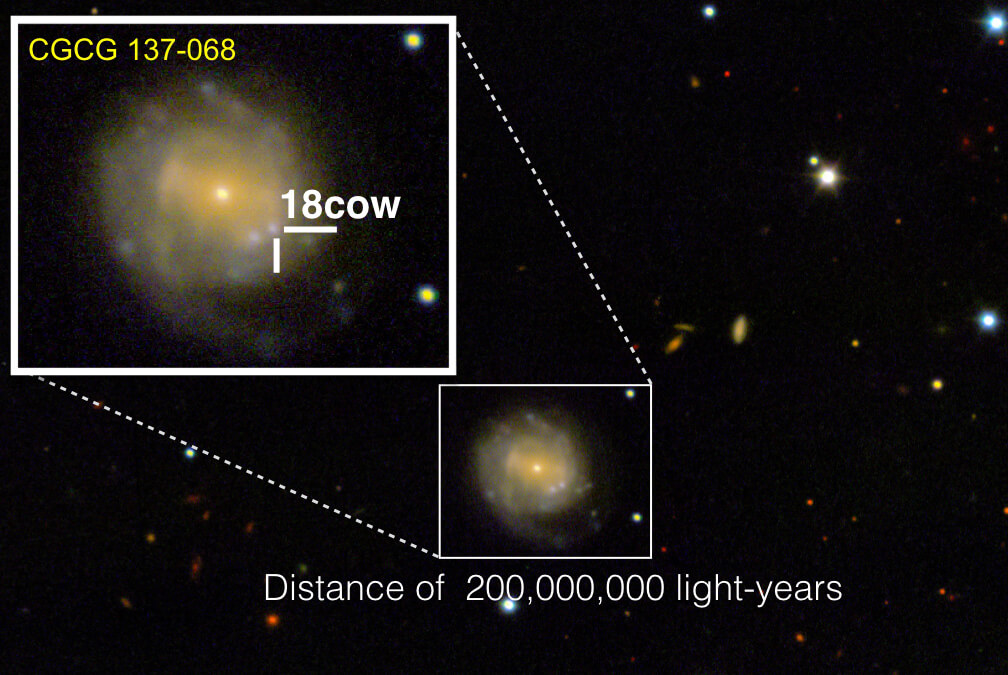ESA’s Integral and XMM-Newton space telescopes, which work with high-energy radiation, helped to find a powerful X-ray source in the center of an unprecedentedly bright and rapidly developing stellar explosion(black hole or neutron star birth) that suddenly appeared in the sky last year. The results of observations in the first 100 days of the object’s existence, covering the entire electromagnetic spectrum of the explosion from radio waves to gamma rays.
The most exciting interpretation is that we could see for the first time the birth of a black hole or a neutron star.
-Raffaella Margutti from Northwestern University (USA), lead author of the article
On June 16, 2018, the ATLAS telescope in Hawaii recorded the phenomenon designated AT2018cow, after which astronomers from around the world sent many space and ground-based telescopes to a newly discovered celestial object located in the galaxy about 200 million light-years from Earth. Soon they realized that there was something completely unusual in front of them: in just two days it exceeded the brightness of any previously observed supernova.
Subsequently, an analysis involving the observations of Integral and XMM-Newton, as well as NASA’s NuSTAR and Swift space telescopes, revealed a source of high-energy X-rays deep inside the explosion. The behavior of this x-ray engine suggests that a strange phenomenon can be either a nascent black hole, or a neutron star with a powerful magnetic field sucking the surrounding material.
The AT2018cow explosion was not only 10-100 times brighter than any other previously observed supernova, it also reached a peak of brightness in just a few days compared to the usual two weeks.
Integral, which covers a range of wavelengths inaccessible to other observatories (including NuSTAR, whose capabilities overlap with the European telescope), began observing the phenomenon about five days after its discovery and continued to monitor it for 17 days. His data were crucial for understanding the strange object.
We saw something like a blow with a sharp clipping in the high-energy region. It is an additional component of the radiation emitted by this explosion through an opaque medium.
-Volodymyr Savchenko, an astronomer at the University of Geneva (Switzerland), who works on Integral data
According to astronomers, this high-energy radiation, most likely, comes from the area of very hot and dense plasma surrounding the source. Since Integral continued to track the AT2018cow explosion for a long period of time, its data also showed a gradual extinction of the high-energy X-ray signal. Scientists believe that it was caused by the so-called processed radiation – radiation from a source that interacts with the material ejected by the explosion. As the material moves away from the center of the explosion, the signal gradually decreases and eventually disappears completely.
However, in this signal, astronomers managed to find patterns typical of an object absorbing matter from the environment: either a black hole or a neutron star.
This is definitely an unprecedented phenomenon in the world of transient astronomical events.
-Raffaella Margutti
Meanwhile, XMM-Newton twice observed an unusual explosion in the first 100 days. The space observatory detected the low-energy part of the x-ray radiation, which, according to astronomers, comes directly from the engine in the explosion core. Unlike high-energy X-rays emitted from the surrounding plasma, low-energy X-rays from the source are still visible. Astronomers plan to continue observations with XMM-Newton in order to study in detail the behavior of the source in the long term and unambiguously determine its nature. Growing black holes leave characteristic X-ray prints that can be detected in the telescope data.
This event was completely unexpected, and it shows much of what we do not fully understand. One tool can never understand such a complex object. The detailed information that we were able to collect about the mysterious explosion of AT2018cow became achievable only through extensive cooperation and the combination of data from many telescopes.
-Norbert Schartel, a researcher at the XMM-Newton project.
Black hole or neutron star birth event
Click To Tweet
The post Black hole or neutron star birth event appeared first on Upcosmos.com.
